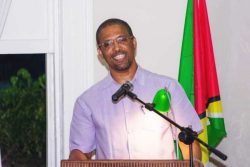It took President Irfaan Ali no time at all to respond, directly, to the reported protestations of some Amerindian leaders and groups over what they appeared to feel was an improper government intervention in the conduct of the closing session of this year’s National Toshaos Conference (NTC). The ‘offended parties’ were reportedly less than sanguine about the idea of the closing session of the forum being chaired by an official of the Ministry of Amerindian Affairs.
What would be the rationale behind a state official not directly connected to either the substantive proceedings or the outcomes of the Conference being inserted into the proceedings at what can be described as the strategic level of Chairman of the presumably crucial concluding session (s) of the forum? One certainly did not get the impression that the President, in his response, sought to address this issue directly. Indeed, the tone of his response suggested that he was not at all keen to go ‘head to head’ with those delegates to the Conference who, reportedly, were dead set against a Ministry of Amerindian Affairs official taking the Chair for the final session. They might have felt that the move was intended to ensure that the conclusions/outcomes of the forum were pleasing to the government, a feeling/concern that may well have been altogether justified given precedent in terms of government’s interest in ‘the politics’ of our Amerindian communities.
The President’s response to the reported concerns of the offended delegates sought to provide assurances that “we (the government, that is) have to answer to you,” a pronouncement, the factualness of which is patently challengeable. Certainly, it is not generally known that, as things stand, the government is, in any way, shape or form, accountable to the country’s Amerindian community. If anything, what obtains suggests that it is the other way around.
There is, of course, every reason to believe that it would have been the wish of President Ali and his government that the outcomes be pleasing to them. They, the President and the government, are only too well aware that, these days, the image of governments in countries with indigenous populations, come under a good deal more global scrutiny under the plethora of international law that set standards in matters that have to do with countries’ mindfulness of the quality of life of indigenous minorities.
This is not something that President Ali and his administration are not aware of. They have, like previous political administrations here in Guyana, persisted in showing no serious interest in the meaningful, long-term enhancement of the quality of life of Amerindians in their communities. Truth be told, as far as we can tell, the relevance of Guyana’s Amerindians reposes, chiefly, in what is loosely described as ‘the Amerindian vote,’ and its relevance to the outcomes of the national electoral process, the final determinant of ‘who rules.’ That is where, many feel, governments’ interest in the country’s Amerindians begin and end.
Substantive national ‘recognition’ of the Amerindian contribution to the contemporary whole reposes, for the most part, in what might be termed heraldic patronage, that is, the emblazoning of indigenous images, motifs et al on our symbols of nationhood, as though this, somehow, compensates for their simultaneous social and political marginalization. Where matters like food insecurity, a paucity of health and education facilities, inhospitable living conditions, high unemployment and an overall lower standard of living, as a people are concerned, it is our Amerindian ‘brothers and sisters’ (as we shamelessly refer to them) who, for the most part, continue to carry ‘the hog’ of the burden.
Put differently, the visual symbolism that government has generously employed to reflect what is usually referred to as ‘the Amerindian presence,’ in Guyana has amounted to little more than a failed attempt to conceal the substantive marginalization of our Amerindian community as a whole. President Ali must surely be aware that no amount of ‘spin’ or reimaging of history can wish/wash that reality away.
Here in Guyana such attention as the rights of indigenous peoples has secured has derived, for the most part, from the tireless efforts of the country’s indigenous stalwarts to embrace their heritage and proclaim their historical relevance. In this regard, it is, one feels, the international community, much more than the local political mainstream that has kept hope alive insofar as ensuring that our Amerindian heritage is not abandoned by the wayside. The sustained mostly UN-driven lobby which yielded outcomes like the September 2007 promulgation of the United Nations Declaration on the Rights of Indigenous Peoples (UNDRIP), to cite, for the purpose of brevity, a single prominent example, have not only played an invaluable role in setting standards for the rights and entitlements of indigenous peoples, but have also, in some instances acted as restraints on the abuse of indigenous peoples in many countries and sent what has become a universal message that ‘big brother’ (the international community) is watching.
UNDRIP, one might add, is “the most comprehensive international instrument on the rights of indigenous peoples. It establishes a universal framework of minimum standards for the survival, dignity and well-being of the indigenous peoples of the world and it elaborates on existing human rights standards and fundamental freedoms as they apply to the specific situation of indigenous peoples.” Put differently, it makes an invaluable contribution to seeking to keep countries like Guyana ‘honest,’ in the matter of Amerindian rights.
Arising out of Guyana’s considerable experience in the realm of international diplomacy our foreign policy pursuits have included tracking the considerable body of work within the UN and other agencies in matters pertaining to the treatment of indigenous peoples, though how much of this becomes infused into our overall governance manual is difficult to say.
President Ali, one must assume, continues to be continually counseled on issues pertaining to the responsibilities of states in the matter of respect for the rights of Amerindians. His prompt response to the small squall that appears to have ensued over the chairing of the final session of the just concluded Toshaos Conference may have been limited in what it had to say, though it has to be said that it appeared to have reflected his sensitivity to both the domestic and external dimensions to matters pertaining to the rights of indigenous communities. Whether that will bring about a meaningful change in government’s behavioural culture in the matter of the treatment of Amerindian peoples and communities including affording them the complete suite of their social and economic rights as bona fide Guyanese is, of course, another matter.








